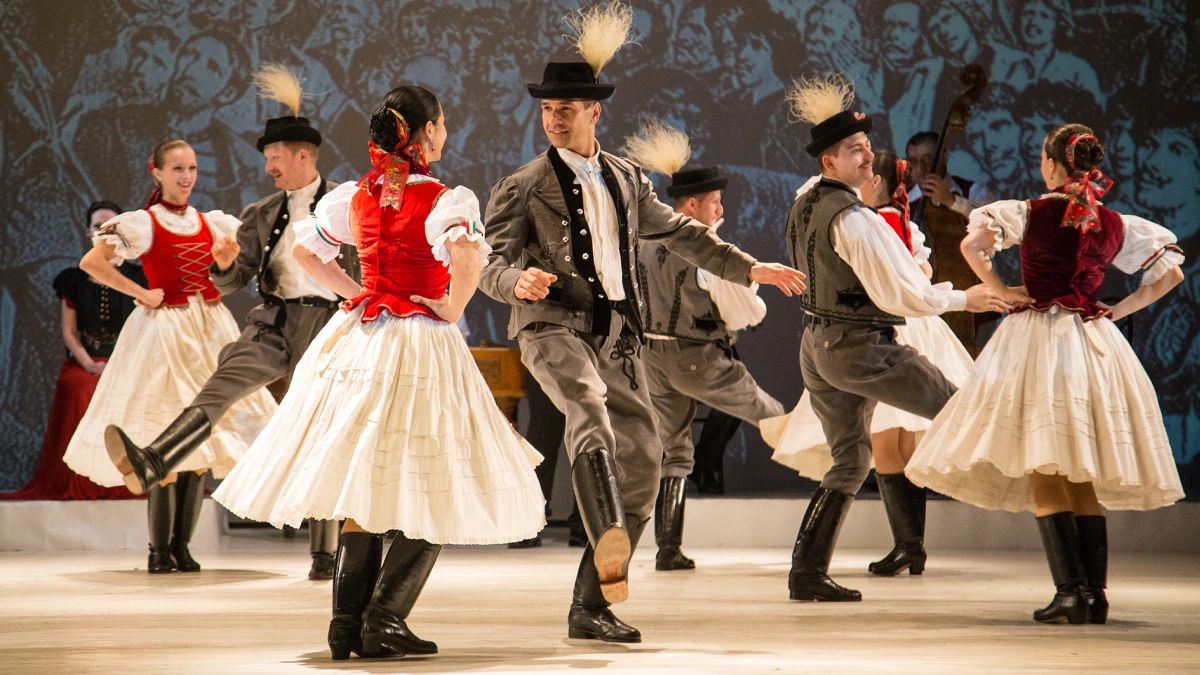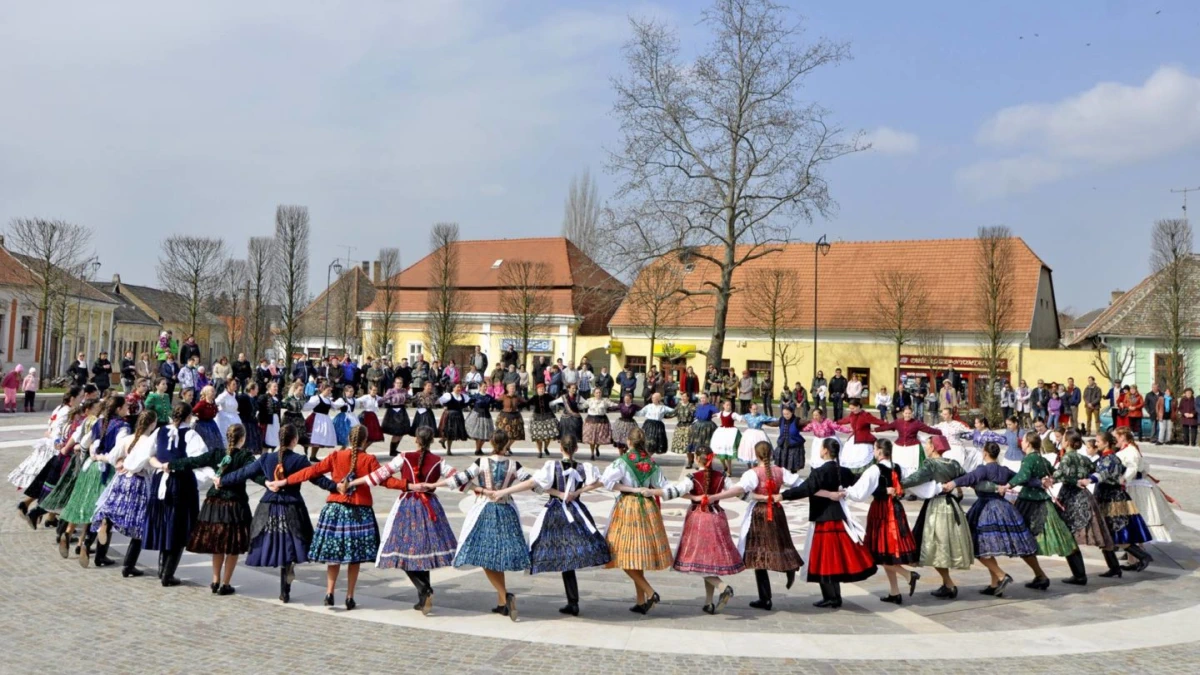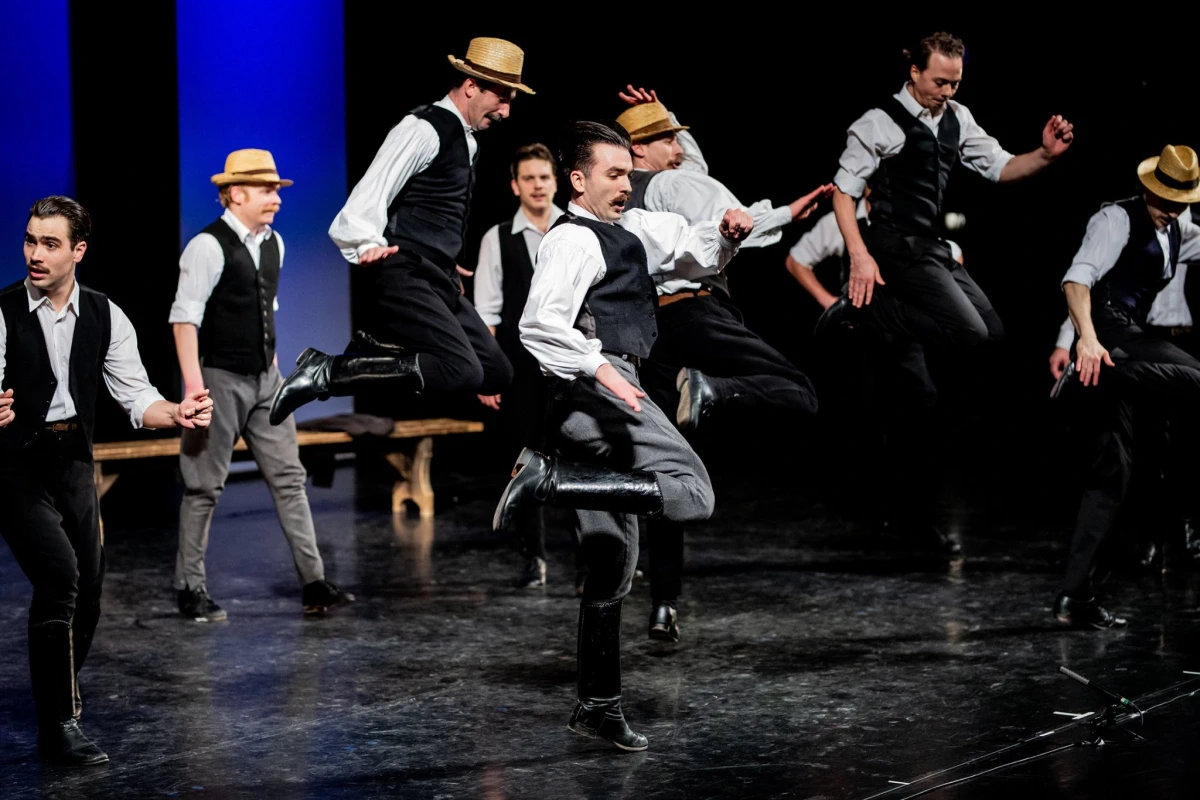Traditional Hungarian folk dance is a vibrant expression of the cultural heritage of Hungary. These dances are deeply rooted in the country's history and traditions, and they continue to be an important part of Hungarian identity. In this article, we will explore the history and significance of traditional Hungarian folk dance, the different styles of dance, and how it has evolved over time.
Note: This article contains affiliate links. In case you purchase something through one of these links, we may receive a small commission at no extra cost for you. Thank you for helping us keep creating the free content on this website!
Introduction
Hungary, a landlocked country in central Europe, is known for its rich cultural traditions, including music, dance, and folk art. Traditional Hungarian folk dance is one of the country's most cherished cultural treasures. It is a lively and colorful expression of Hungarian history, customs, and way of life.
Brief History of Traditional Hungarian Folk Dance
Hungarian folk dance has a long and rich history, dating back to the days of the Magyar (Hungarian) tribes who first settled in the Carpathian Basin over a thousand years ago. The Magyars brought with them a rich cultural heritage that included dance, music, and storytelling.
Our knowledge regarding the ancient dances of the Hungarian people is quite limited. However, we can deduce that these dances had religious origins. The religious beliefs of the ancient Hungarians were closely linked to those of their ethnic counterparts, such as the Bulgarians, Turks, and Kazars. One significant aspect of their belief system revolved around the concept of the soul, with the main doctrine focusing on ancestor worship. They believed that the magic of their ancestors safeguarded their descendants. Conversely, if the souls of their ancestors were not appeased, it was believed that their descendants would be plagued by illness, death caused by epidemics, or other perilous forces of nature.
Ancestor worship also entailed the observance of funeral ceremonies and feasts held in honor of the deceased. During these rituals, a specific practice known as the Dance of Death was performed. This dance held such profound importance in the ancestral worship of the ancient Hungarians that their descendants continued to carry out these ceremonies for many centuries, whether openly or in secret, even after the arrival of Christianity. The exact manner in which the Dance of Death was performed by the ancient Magyars remains unknown. However, it is likely that the war-dance played a significant role, particularly during the commemoration of a heroic figure's funeral.
Over time, the dance evolved into a complex and sophisticated art form that was influenced by various historical events, including the Turkish and Austrian invasions, as well as the peasant uprisings of the 18th and 19th centuries.
Following the advent of Christianity and throughout the 16th century, a growing body of authentic documents emerges, providing evidence of the presence of Hungarian dance and the Hungarian people's deep passion for dancing. However, while these documents acknowledge this fact, they do not offer any substantial explanations or insights.
The Significance of Traditional Hungarian Folk Dance
Traditional Hungarian folk dance is a powerful symbol of Hungarian national identity and pride. It reflects the country's unique history, traditions, and way of life, and is a testament to the resilience and creativity of the Hungarian people.
Hungarian folk dance is also an important social and cultural activity. It brings people together, fosters a sense of community, and provides a platform for artistic expression and creativity.
Folk Dance Styles
There are several different styles of traditional Hungarian folk dance, each with its own unique characteristics and regional variations. Some of the most popular styles of Traditional Hungarian folk dance include:
Czardas ("Csárdás")
The history of the verbunk's successor, the Csárdás, dates back to the 1830s. It was then that it took over from its predecessor as a Hungarian national dance that became popular among all social classes - as an idealised peasant dance - even among the aristocracy. Just like its dotted rhythm ancestor, the Csárdás consists of two distinct parts, a 4/4 time slow and a 2/4 time fast.
Other rhythmic variations can also be distinguished, such as the dense ("friss"), the rare or slow ("lassú") and the leaping ("szökős"). The dance is danced by a couple of men and a woman. The women wear a traditional, multi-layered skirt, usually red, which takes on a distinctive shape as they dance. As in the waltz or polka, the man leads, but the Csárdás has a much richer variety of dance steps. In the fast part, the partners often separate (throwing) and dance separately, with the men performing spectacular dance elements such as pirouettes, boot-clapping, i.e. slapping and drumming.
Hungaricums, treasures that Hungary bestows upon the world, encapsulate the nation's unique essence, a testament to its legacy and craftsmanship, mirroring the crescendo of its people's endeavors. Csárdás belongs to Hungaricums.
The music that accompanies the Csárdás dance is known for its catchy melodies and rhythmic variations. It is often played by traditional Hungarian folk instruments like the violin, clarinet, and cimbalom (a type of hammered dulcimer). The music captures the emotions and dynamic shifts of the dance, enhancing the overall experience.

Verbunkos
Verbunkos is a traditional Hungarian folk dance style and music genre that originated in the 18th century. It was initially associated with recruiting soldiers for the Hungarian military, known as "hussars," during the Austro-Hungarian Empire. The term "verbunkos" itself refers to the recruitment process while the word "verbunk" comes from the German word "Werbung" (=recruitment).
The dance and music style of verbunkos evolved from the melodies and rhythms played during the recruitment events. It combines elements of Hungarian folk music with influences from other European styles, particularly those of the Austrian and Roma (Gypsy) traditions.
Verbunkos as a dance can be divided into two groups: solo verbunk and circle verbunk. The solo verbunk is rich in form, improvisational (improvisatory) elements, and is widespread throughout the country. Its informal melodic form allowed both music and dance to undergo further transformations.
Verbunkos music is typically characterized by a lively and spirited tempo, featuring distinctive rhythms and melodies. The melodies often alternate between slower, expressive sections and faster, energetic passages. The music is performed by a variety of traditional Hungarian instruments, such as the violin, clarinet, cimbalom (a hammered dulcimer), and double bass.
In terms of dance, verbunkos is often performed as a solo dance, with a male dancer showcasing their skills and agility. The dance movements are lively and athletic, incorporating elements of jumping, spinning, and intricate footwork. The dancer's movements are often synchronized with the music, creating a vibrant and engaging performance.
Over time, verbunkos has become an integral part of Hungarian folk music and dance repertoire. It is frequently performed at cultural events, festivals, and dance competitions, showcasing the rich heritage and traditions of Hungarian music and dance.

Hoop dance ("Karikázó")
The karikázó is a playful and joyful dance that is performed in a circle. It is typically danced by young people, especially women and is characterized by lively footwork and playful interactions between the dancers.
The hoop dance, linked to the spring fertility rites, was mainly a dance of the fasting period and feast days without festivities (the fasting girls' dance). It is occasionally included in the order of organised festivities during the dance breaks and at the beginning of the dance. The accompaniment of the carillon is always a monophonic chant.
Their most important element is the song, and so it is not the alternation of steps that is important, but the lyrical songs with their numerous lyrical strophes. The hoop dance is a unified dance with a controlled structure, because the girls' closed, circular chain does not allow for individual improvisation. The sequence of steps is fixed, but the amount of repetition and the length of the sections can vary depending on the mood of the moment, but applies to everyone. The ways of chaining are: simple and crossed front or back handholds, armlocks, and shoulder or waist holds.
Karikázó, as a traditional Hungarian folk dance is not only a form of entertainment but also a way to preserve and showcase Hungarian cultural heritage. It is often performed at folk festivals, weddings, and other traditional celebrations, allowing both locals and visitors to experience a glimpse of Hungarian traditions and customs. The dance also plays a role in fostering a sense of community and togetherness among the participants, as the coordinated movements require teamwork and synchronization.

Palóc
The palóc is a popular dance that is performed in the northern part of Hungary. It is a slow and graceful dance that is characterized by gentle movements and intricate footwork. It is an integral part of the Palóc culture and is often performed at various festive occasions, including weddings, festivals, and cultural events.
Palóc dance is typically performed by a group of dancers, both men and women, who wear traditional attire representing the Palóc region. The women usually wear colorful floral skirts with aprons, embroidered blouses, and headscarves, while the men wear vests, white shirts, black pants, and boots.
The dance is characterized by lively and energetic movements, with participants forming various patterns and formations. It often involves intricate footwork, spinning, clapping, and hand-holding, creating a vibrant and joyful atmosphere.
The music accompanying Palóc dance is typically provided by traditional Hungarian instruments such as the violin, clarinet, or cimbalom. The melodies are lively and cheerful, setting the pace and rhythm for the dancers.
Palóc dance serves as a cultural expression and celebration of the Palóc people's heritage and traditions. It showcases the beauty, unity, and sense of community within the Palóc community, and it has become an important symbol of their cultural identity.

Kanásztánc
Kanásztánc typically involves a group of dancers, usually men, who mimic the movements and actions of shepherds. The dancers often wear traditional Hungarian attire, which may include embroidered vests, white shirts, black pants, and boots. They may also carry props such as shepherds' crooks or sticks.
The dance itself is characterized by lively footwork, stomping, and jumping, accompanied by rhythmic clapping and shouts. The dancers form various patterns and formations, weaving in and out of each other while maintaining the lively pace and synchronization.
Legényes
Legényes is a traditional Hungarian men's solo dance that is commonly performed in Hungarian folk dance repertoire. The word "legényes" translates to "bachelor" in English, and the dance is often associated with young men's vitality and exuberance.
Legényes is characterized by fast-paced footwork, athletic movements, and acrobatic elements. The dancer typically wears traditional Hungarian attire, including loose trousers, a vest, and a hat or cap. The dance is often performed to lively and energetic music, with the rhythm provided by traditional instruments such as the violin, clarinet, or cimbalom.
The dance showcases the dancer's agility, strength, and skill as they execute intricate footwork patterns, spins, jumps, and leaps. It often includes elements such as heel clicks, stomping, and swift changes in direction. The movements are often improvised, allowing the dancer to display their individual style and creativity.
Legényes is not only a form of entertainment but also a celebration of Hungarian masculinity, youth, and the rural traditions associated with it. It reflects the vitality and dynamism of Hungarian folk culture and serves as a testament to the physical prowess and spirit of young men.
Legényes is a popular dance form within the Hungarian folk dance community and is often performed at festivals, cultural events, and competitions. It continues to be cherished as an important part of Hungarian cultural heritage and serves as a symbol of tradition, identity, and community.

The Evolution of Traditional Hungarian Folk Dance
Over time, traditional Hungarian folk dance has evolved and adapted to changing social, cultural, and artistic trends. Today, it is a vibrant and dynamic art form that continues to captivate audiences around the world.
One of the most significant changes in Hungarian folk dance has been the incorporation of modern dance elements and techniques. Contemporary choreographers have experimented with new movements, styles, and themes, while still maintaining the essential elements of traditional Hungarian folk dance.
Can anyone learn traditional Hungarian folk dance?
Yes, anyone can learn traditional Hungarian folk dance. There are many dance schools and workshops in Hungary and around the world that offer classes and training in Hungarian folk dance.
There are also dance workshops for those who already know the steps and for those who are trying the steps for the first time. These are places where they teach the basic moves while everyone has a great time to live music. You can do it in every dance house.
Dance House Movement
The Dance House Movement, also known as Táncház Movement, is a cultural and social phenomenon that originated in Hungary in the 1970s. It emerged as a response to the restrictive cultural policies of the time and aimed to revitalize and promote traditional Hungarian folk music, dance, and culture.
The Dance House Movement began as grassroots initiatives where people would gather in community centers, houses, or other venues to learn and participate in traditional Hungarian folk dances. These dance houses provided a space for people of all ages to come together, learn traditional dances, and enjoy live folk music performances.
The movement was not limited to dance alone but also included other forms of traditional folk arts, such as folk singing, playing traditional instruments, storytelling, and crafts. It aimed to preserve and pass down the knowledge, skills, and cultural heritage associated with Hungarian folk traditions.
The Dance House Movement played a significant role in the revival and popularization of Hungarian folk culture. It provided a platform for both experienced performers and amateurs to showcase their talents, exchange ideas, and contribute to the preservation and evolution of folk traditions.

In addition to its cultural significance, the Dance House Movement also had a social aspect. It fostered a sense of community, bringing together people from different backgrounds and generations to celebrate and engage with their shared cultural heritage. It promoted inclusivity, creativity, and active participation, emphasizing the importance of collective learning and cooperation.
The influence of the Dance House Movement has extended beyond Hungary, inspiring similar initiatives and communities worldwide that aim to preserve and promote traditional folk arts and culture.
Tips: If you've never tried folk dancing before, it might surprise you to learn that there are still plenty of people frequenting dance halls in Budapest. On almost any given day, there are events where both amateur and professional dancers come together to dance. If you're interested in joining in on the fun but don't have any prior experience, don't worry. There are dance classes available at these community gatherings, and we'll explore some of the best places to check out:
- Szimpla kert: 1075 Budapest, Kazinczy street 14
Every Monday 22:00 -03:00
Free of charge - Pótkulcs: 1067 Budapest, Csengery street 65/B
Tuesday evening from 20:00 to 23:30
Free of charge - Fonó: 1116 Budapest, Sztregova street 3
Wednesday evenings with live music
Ticket price: 1000 HUF. - Rácskert: 1072 Budapest, Dob street 40
Every friday with live music
Free of charge - Buda Vigadó: 1011 Budapest, Corvin square 8
Saturdays 19:00 - 2:00
Entrance fee: from 19:00 1.000 HUF (dance lessons + dance house)
from 21:00 500 HUF dance floor
What is the future of traditional Hungarian folk dance?
Traditional Hungarian folk dance has a bright future ahead. Despite the challenges posed by modernity and globalization, the dance continues to thrive and evolve, and new generations of dancers are carrying on the tradition.
Conclusion
Traditional Hungarian folk dance is a vibrant expression of Hungary's rich cultural heritage. It reflects the country's unique history, traditions, and way of life and is an important social and cultural activity that brings people together. Whether performed in the villages of rural Hungary or on the stages of the world's great concert halls, traditional Hungarian folk dance continues to captivate audiences with its beauty, energy, and vitality.
For more content and exciting articles, follow our site, where we regularly update our column to bring you the best ideas for events or things to do in Budapest!



























